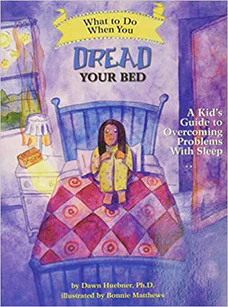What to Do When You Dread Your Bed
A Kid's Guide to Overcoming Problems with Sleep
Written by Dawn Huebner, Ph.D.
Illustrated by Bonnie Matthews
96 pages
•
Published 2006 (Magination Press)

Recommended Age Range: Ideal for 1st through 5th grade, but much of the workbook is applicable to kids a bit younger with some extra parental support.
Publisher's Summary:
What to Do When You Dread Your Bed guides children and their parents through the cognitive-behavioral techniques used to treat problems with sleep. Fears, busy brains, restless bodies, and overdependence on parents are all tackled as children gain the skills they need for more peaceful nights. This interactive self-help book is the complete resource for educating, motivating, and empowering children to fall asleep and stay asleep — like magic!

Dr. Annie's Takeaways
Recommended for: This interactive workbook is a good fit for any child experiencing sleep challenges. It’s appropriate for kids who resist going to sleep, who are struggling to sleep on their own, who have difficulty falling asleep, and those who wake up frequently during the night. It teaches pre-bed relaxation skills, helps a child develop a good bedtime routine, and addresses fear of the dark, nightmares, and scary thoughts that often arise at bedtime. This workbook uses a metaphor of a child being a sleep magician, and it teaches kids fun slight-of-hand magic tricks in each chapter.
Would a child like it? Children are often less motivated than their parents to learn to fall asleep and stay asleep on their own, in their own beds, and even the most fun book isn’t likely to change this.That said, the magic tricks sprinkled throughout the book are pretty fun, and Dr. Huebner makes the routine changes and skills needed to improve sleep as palatable as possible. A child who is at least somewhat motivated to be able to sleep more independently would likely connect with this book. The aspiring magicians out there might be the most likely to actually enjoy it.
Tone: Instructive, empowering
Story Quality: It’s a how-to guide, rather than a story. That said, Dawn Huebner is so great at picking metaphors to make psychological ideas more easily understandable and fun. This book uses a magician metaphor to motivate children to practice the different skills and routines needed to improve their sleep. It’s very effective, especially if the child reading the book is at all interested in learning to perform magic tricks (most of the skills taught in this book are first introduced by teaching the child a magic trick–how fun is that?!). The writing is clear and developmentally appropriate, and it speaks directly and respectfully to the child reading the workbook. There are periodic activities for a child to complete in the workbook, such as writing their ideas for a good “snug” activity (i.e., an activity to help the child feel safe and cozy), which are engaging and useful.
Illustrations: Black and white watercolor illustrations to accompany the text
Representation: Children with different skin tones, hair, and genders are portrayed in the illustrations throughout the text. A few examples include mentions of Mom or of Dad. This book assumes that the child reading it sleeps in a bed in a room that is separate from their parent(s)’ room. Many of the activities in the book require some finger dexterity (e.g., manipulating a rubber band, dealing playing cards).
Psychological Practices: One of the biggest challenges to helping children improve their sleep is motivating them to give up many of the (often enjoyed) accommodations that have been put in place in a well-intentioned attempt to manage the child’s sleep challenges (e.g., late bedtimes, sleeping with parents, protracted bedtime routines). This book does such a lovely job motivating children and their parents in a fun and loving way to reset bedtime, and it gives a step-by-step guide to effectively do so. These steps include: identifying an appropriate bedtime and establishing a plan to work back to this if a child is currently going to bed too late; psychoeducation
about eliminating screen time before bed (almost all kids have already heard this, but I thought this was a particularly convincing, child-friendly explanation for why it is important); creating a bedtime routine (“shift, snug, snooze”); addressing fear of the dark and of being alone through a fun hide-and-seek game; a step-by-step plan for moving towards falling asleep alone; a reward system for reducing parent call-backs (e.g., for water, worries, questions); thought shifting away from scary thoughts (e.g., monsters) toward pleasurable thoughts, as well as fun exposure exercises for scary thoughts that won’t go away (i.e., exposure for intrusive thoughts); scheduling “talk time” with parents earlier in the day rather than before bed; breathing exercises and a “dream box” of pleasurable things to think about before bed; strategies to increase feelings of physical comfort (e.g., a light bedtime snack, getting enough exercise during the day, being the right temperature), and strategies for nighttime awakenings and nightmares (i.e., reimagining the ending of a nightmare in an empowering, less scary way).
Concerns: Nope
